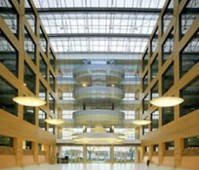Can you be Comfortable in a Green Building?
 Building performance and its evaluation have earned increased attention in recent years, particularly relating to green buildings. Much of the emphasis has been on optimizing energy and resource efficiency. Despite the recent media buzz around the actual performance of LEED-certified buildings, surprisingly little attention is being paid to the human resource within buildings.
Building performance and its evaluation have earned increased attention in recent years, particularly relating to green buildings. Much of the emphasis has been on optimizing energy and resource efficiency. Despite the recent media buzz around the actual performance of LEED-certified buildings, surprisingly little attention is being paid to the human resource within buildings. Green buildings, according to the Canada Green Building Council (CaGBC), are buildings designed to balance environmental responsibility while providing a comfortable, healthy and productive environment within economic means.
In contrast to their conventional counterparts, green buildings often rely on natural air conditioning to meet the comfort needs of end-users. A combination of ’passive’ design strategies [pdf] may be used to provide indoor comfort conditions, including the use of mass to retain and radiate heat, passive solar heating, passive cooling, natural ventilation and daylighting.
The resulting indoor environmental quality may be far superior from the perspective of building occupants. Indoor air quality in green buildings is enhanced by supplying high levels of outside air and using low pollutant materials; indoor conditions are often more closely linked to outside conditions; the use of natural light supports ’biophilic instincts’, along with views to the outdoors, and direct contact with nature; and occupants may have a greater amount of personal control over their workspace through opening and closing windows, blinds, switches and other manual controls.
Improved indoor environmental quality can benefit building owners, not only in terms of improvements in occupant comfort and health but also productivity. Seminal work [pdf] by the Rocky Mountain Institute links efficient lighting, heating, and cooling to measurably increased worker productivity, decreased absenteeism and improved quality of work in eight case-study buildings.
A web-based tool, e-Bids, now available from the Centre for Building Performance and Diagnostics at Carnegie Mellon University, documents the power of arguments to date for various green building design strategies in terms of energy savings, health cost savings, productivity gains and return on investment. The take home message from these landmark studies is that occupant comfort, health and productivity can payoff just as much as energy and resource conservation over the lifetime of a building.
Do all green buildings lead to improvements in user experience?
Evidence from recent post-occupancy evaluation studies suggests not. A study [pdf] by the Centre for the Built Environment, U.C. Berkeley, comparing satisfaction between green and non-green (or conventional) buildings, found that occupants in the green buildings were more satisfied on average with the building overall; they were also more satisfied with air quality and thermal comfort.
However, they were, on average, less satisfied with lighting and acoustics as compared to conventional buildings. In similar work by the Usable Buildings Trust, U.K., green buildings as a group scored better on indoor environmental quality factors, while a few of the lowest scoring buildings were also green, especially in terms of glare and acoustics.
In contrast, a study by the Pacific Northwest National Lab of General Service Administration buildings found higher satisfaction in green buildings across the board
You can return to the main Market News page, or press the Back button on your browser.



